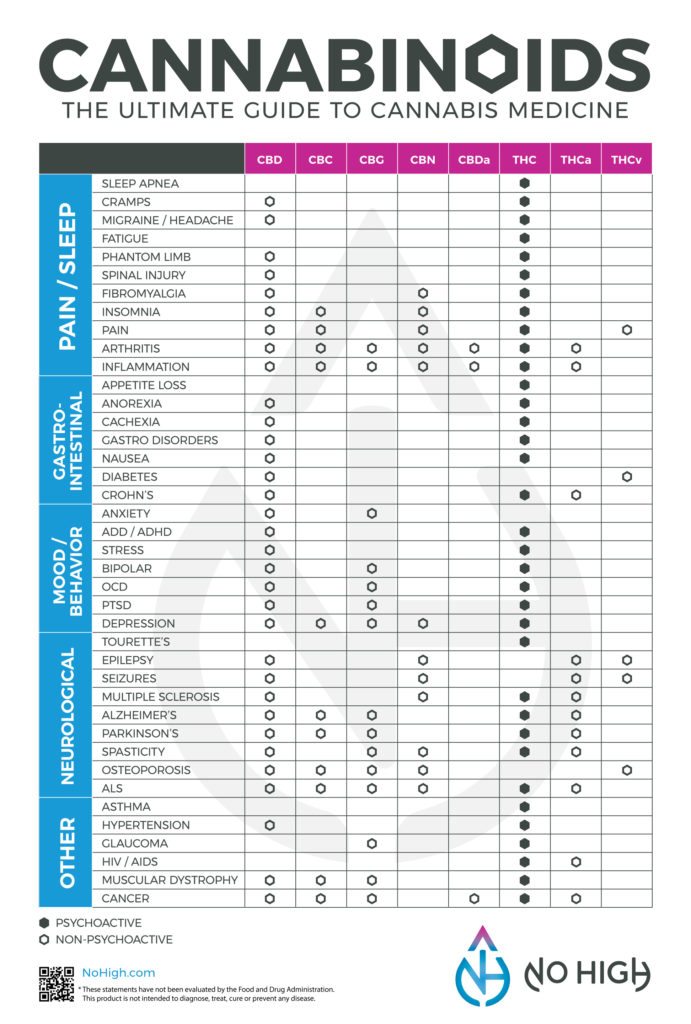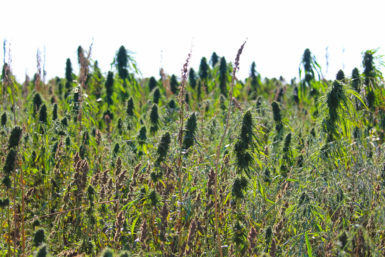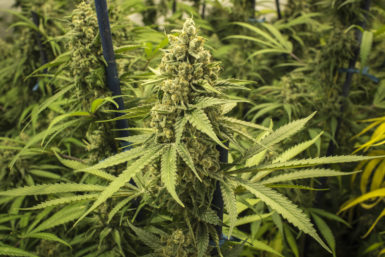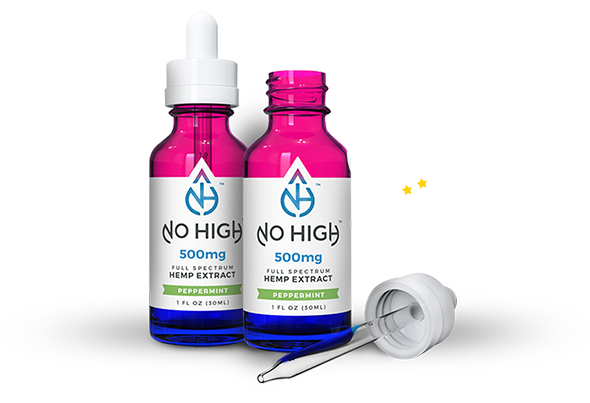If you want the answer to “What is CBD oil?”, then you’ve come to the right place. CBD oil is a hot topic right now, and various other questions revolve around it as well. Studies have shown that numerous CBD oil benefits exist for health, all while avoiding any of the “high” feelings that THC containing marijuana might have. Amazon has even started selling hemp oil, which is not CBD oil. Topicals are now showing up in CVS as well.
What Does CBD Mean?
Many people are wondering, “What is CBD?” Cannabidiol (CBD) oil is an extraction of the Cannabis sativa plant. CBD is a non-intoxicating cannabinoid that is becoming very popular with people looking for natural products for symptom relief.
You might also be wondering what is CBD with THC vs. what is CBD without THC? CBD with THC are products containing psychoactive levels of THC; you may only purchase these in states with recreational or medical marijuana programs.
Non-psychoactive hemp-derived CBD oils can legally be bought and sold across the country.
“Cannabidiol (CBD) is one of 100+ cannabinoids from the cannabis plant. CBD is becoming popular for having a broad scope of benefits and showing little to no side effects.”
The best CBD oil feature is that it can provide symptom relief for a wide array of health problems, and support overall health and wellbeing. Different delivery methods of taking CBD exist. These methods include vaping, sublingual tinctures, capsules, topically, and edibles such as CBD gummies.
What is CBD Oil Made From?
So what is CBD oil made from anyways, hemp or marijuana? Both hemp and marijuana yield CBD. Additionally, CBD can be derived from either indica or sativa plants, depending on the overall effect the user wishes to have. Any variety of cannabis can be extracted to create products with different results. Some boutiques will create product lines from different types of cannabis strains to cater to particular symptoms.
Cannabis extracts come out thick and sticky. Carriers like coconut oil or sesame oil are added to cannabis extracts to thin them and aid delivery. Flavoring may also be added to improve the taste of the CBD extract. Most CBD products contain very few ingredients since producers know users are looking for a more natural or organic CBD product.
Pros and Cons of CBD vs THC
Consumers should be aware of the pros and cons of the different types of CBD products. When deciding between extracts with only CBD vs. those also containing THC, it is essential to know what CBD oil made from in the products you are buying. So what is the difference between CBD vs. THC?
Oils with significant levels of both CBD and THC will have a psychoactive effect which can be undesirable for managing symptoms, especially during the day. THC is also responsible for many of the side effects of cannabis. Many people feel the best CBD oil comes from hemp, which provides symptom relief and allows them to function normally through their day.
CBD vs Medical Marijuana
The pros and cons of CBD oil also depend on the symptoms a person is looking to relieve. In addition to CBD and THC, some extracts will also contain other cannabinoids and terpenes that support the relief of particular symptoms and conditions. “Full-spectrum” CBD hemp oil products are a type of CBD oil that contains terpenes and other cannabinoids.
Even if THC may benefit a particular symptom, you can try a non-psychoactive CBD hemp oil before seeking an option that would require a medical marijuana card. Not all states have medical marijuana programs. This means that CBD may be the only option for many.
What is CBD Oil Good For?
In addition to CBD and THC, cannabis contains several other cannabinoids. These include cannabinol (CBN), cannabigerol (CBG), tetrahydrocannabivarin (THCV), cannabichromene (CBC), and over 100 others. THCA and CBDA are the acidic forms of cannabinoids. After decarboxylation by heat and light, these forms are no longer acidic. Don’t worry if the COA for your hemp extract has these. Cannabinoids that have not been decarboxylated can still have health benefits.
“CBD oils have antioxidant, anti-inflammatory, and neuroprotective properties that support overall health and symptom relief.”
CBD oil has demonstrated extensive medical benefits for symptoms of chronic pain, anxiety, and neuralgia. Patients with diseases like multiple sclerosis (MS), cancer, and AIDS have also found symptom relief from medical marijuana and non-psychoactive CBD products.
Full-Spectrum CBD Benefits
Full-spectrum CBD oils capture a wide variety of cannabinoids along with other beneficial plant compounds like terpenes.
What is full-spectrum CBD oil? Full-spectrum CBD is derived from the whole hemp plant. In many cases, full-spectrum can be considered more useful than isolated CBD. Full-spectrum oils can take advantage of more biological pathways for having more cannabinoids. This phenomenon is known as the “entourage effect.”

What is CBD Oil Dosing?
People considering using a cannabinoid product in any form should consult their physician for dosage recommendations. Dosing varies widely based on the type of product used (such as CBD oil, CBD oil tinctures, and smokeable CBD).
Research studies have shown that CBD oil dosage up to 1500mg per day can be well-tolerated, but doses as small as 2.5mg can be useful for some symptoms as well.
CBD has effects that promote and maintain health at lower doses. These include antioxidative, anti-inflammatory, and neuroprotection effects. Even for strong symptoms, high doses of CBD may not be needed.
CBD Oil Dosage Suggestions
- Start at a low dose and gradually increase (known as titrating)
- Continue dosage that provides symptom relief
- Don’t take more CBD oil than what is needed
- Capsules may require higher doses
- Lower doses may be enough for tinctures and vapes
CBD can work on different body mechanisms depending on the dose concentration, the composition of the product, and the individual’s body chemistry. There is no set dose recommendation or limitation for CBD. The occurrence of CBD side effects can be taken, in a practical sense, as a sign that a dose is too strong. Tracking dosage in a journal can be helpful in finding the optimal dose and finding the most beneficial products.
Buying CBD Online
Pay close attention to the CBD products you find for sale online. This is especially true when you buy CBD from Amazon, eBay, or classified apps. Real CBD oil is not allowed for sale on these sites so sellers tend to use tricky language to sell substandard oils to unwitting consumers. Products such as hemp seed oils do not contain any CBD whatsoever, but that is likely what you’ll be buying (and overpaying for).
Delivery Methods
Taking CBD via different methods determines the bioavailability of the CBD taken. Bioavailability is how much CBD the body can use. It is also a measurement of how fast feeling CBD effects take. Vaping CBD and taking it sublingually using tinctures are the top two best methods for quick and potent dosing. Consuming edible products such as CBD oil capsules and CBD gummies reduces potency and take longer to feel the effect.
Information on dosing reflects reports from peer-reviewed journal articles and common online recommendations. This information should in no way, be perceived as a recommendation made by a licensed doctor. Non-prescription cannabis-derived products have not been evaluated for safety by the FDA and have not undergone clinical trials. Always consult a doctor for their guidance on cannabis-based products.
Genetics of Cannabis
There are over 8,000 different unique genetic varieties of cannabis. Each variety is called a strain. Cannabis strains can be classified in different ways, by their parent plants, by the cannabinoid content, or by the effect. More broadly, cannabis can be classified by the three major varieties, so what is CBD oil like from each of these sources?
Cannabis indica, Cannabis sativa, and Cannabis ruderalis are considered the three main subtypes or species of cannabis. The scientific community has highly debated the number of cannabis species. Just one species was originally designated- Cannabis sativa. Genetic studies and analyses of plant anatomy, morphology, and biochemistry have supported a modern classification that differentiates indica and sativa. Some still believe that ruderalis may not be a genuine species, but a wild variation.
Difference Between Sativa vs. Indica
Sativa and indica have significant differences in plant shape and geographic origin. The topic of whether cannabinoid contents are truly dependent on species has often been debated. In drug-type plants (marijuana), sativa is commonly stereotyped as having a more energizing high while indica is known for more sedative deep body relaxation.
Since most cannabis varieties are hybrids of sativa and indica, the species of the plant is not very useful in describing a strain’s medicinal qualities.
Classifying cannabis by its chemical makeup, known as its chemotype, is more useful for evaluating a strain’s medicinal qualities. For growers, decisions about harvesting and how the plant grows are relevant to the difference in species.
| Trait | Cannabis sativa | Cannabis Indica |
| Leaf Shape | Thin leaflets | Wide leaflets |
| Leaf Color | Brighter green, yellow | Dark green, purple |
| Plant Height | Tall and skinny (8-12 ft) | Short and bushy |
| Flowering | Late Fall | Earlier (beginning of September) |
| Buds | Lighter green, long | Dark green to purple, fatter |
| CBD vs. THC | Generally higher THC and lower CBD | Generally higher CBD |
| Origins | Worldwide from Asia to South America and Africa | Afghanistan, Pakistan, India |
Difference Between CBD From Marijuana vs. Hemp
Marijuana is a term used for the drug-type of cannabis that contains psychoactive levels of THC. Hemp is a type of sativa that has less than 0.3% THC, which is not enough to produce an intoxicating effect. When hemp-derived, the chances of failing a CBD drug test are slim, but not impossible.
Both indica and sativa have drug-type varieties, and while they have a reputation for recreational use, drug-type cannabis also has significant medical benefits. So, what is CBD oil like when derived from different plant species? CBD oil can come from either marijuana or hemp, but hemp has many advantages. Hemp is also the primary plant that derives legal CBD (less than 0.3% THC)..
Advantages of Hemp for CBD Oil Production
- Grows with fewer resources than marijuana
- Is a highly sustainable crop
- Naturally has less than 0.3% THC
- Has naturally high levels of CBD
- Beneficial hemp compounds, such as fatty acids, add to health benefits.


A crop of hemp (top) is much taller and skinnier with smaller floral buds compared to the marijuana crop (bottom) which has bigger and bushier leaves and flowers.
Chemotypes Clarify Marijuana vs. Hemp
In addition to classifying cannabis genetically as sativa, indica, or ruderalis, we can also classify it by its bioactive compounds. This type of classification is known as a “chemotype.”
There are three significant cannabis chemotypes. Each of these has different cannabinoid and terpene potencies and also have different medicinal effects. Growing conditions can influence cannabinoid levels, so groupings made on genetics are generalizations.
Chemotype I cannabis plants are varieties of cannabis with high levels of THC. These varieties are thought to originate from locations below the 30°N latitude. Chemotype II cannabis plants are varieties with varying or equal levels of THC and CBD. These, along with chemotype III cultivars, are found naturally above the 30°N latitude.
Varieties of cannabis with high levels of CBD and low levels of THC are chemotype III. What is CBD oil chemotype III? In short, it is the chemotype which is commonly known as hemp. These plants can be used for a wide variety of applications (clothing, rope, biofuels, and CBD oils) as they are rich in fiber.
CBD Extraction Methods
There is a wide variety of extracted cannabis products on the market. The processes used to extract cannabis oil have an impact on the quality of the product and the effects it will have. What is CBD oil extraction then? Solvent extraction is a common method for manufacturing CBD. Olive oil has been used to make homemade CBD oil. Surprisingly, olive oil can preserve more beneficial cannabis terpenes than alcohol solvents. Most CBD extraction methods use hydrocarbon extraction or ethanol extraction. A third common option is carbon dioxide (CO2) CBD extraction.
CO2 CBD Extracts
Supercritical CO2 extraction is a cold extraction process. It uses carbon dioxide to extract cannabinoids and other plant compounds. A subcritical CO2 cycle can be run prior to the supercritical cycle. Doing this will extract terpenes from the plant. After post-processing steps to purify extracts, the subcritical extract and supercritical extract can be combined. This method is one of the best for producing full-spectrum CBD products that include terpenes. Vacuum drying ovens are also good for two-step extractions for full-spectrum CBD oil.
What Are CBD Terpenes in the Cannabis Entourage
Glandular trichomes found on cannabis buds produce resins that contain cannabinoids like THC, CBD, and terpenes. A plant’s terpenes are part of what gives it its unique characteristics like smell and taste.
Cannabinoids aren’t the only beneficial compounds in cannabis. There are over 100 terpenoid compounds in cannabis, many with bioactive properties that boost the overall effects of cannabis through the “entourage effect.” Hopefully, that answers your question of what is CBD terpenes.
The entourage effect is the ability of a more diverse compound spectrum to take advantage of more biological pathways. There are at least 60 different routes cannabis compounds can take to affect the human body. Compounds can act on more body systems by using more of these routes.
Terpenes and Terpenoids
Terpenes and terpenoids derived from them are a key ingredient in the essential oils of plants and flowers. Plant genetics, soil nutrients, plant stress, light, and heat are major factors that can alter or degrade a plant’s terpene profile. Unlike the cannabinoid profile of a cannabis plant, the terpene profile is not genetically stable through strains. Depending on the growth of the plant, the terpene profile can change.
Terpenes can influence the medicinal qualities of cannabis by working in synergy with cannabinoids to improve their therapeutic effects. Terpenes are thought to help with anxiety, inflammation, bacteria, and the sedative effects of cannabis.
People have more recently become interested in terpene-only supplements. Terpenes have medicinal properties of their own and can act on the endocannabinoid system and other body systems without the help of THC or CBD.
Major Cannabis Terpenes and Their Effects
There are many different cannabis terpenes, each having its unique effect. What are CBD terpenes then, and what do they do? Following is a comprehensive list:
- Myrcene
- Ocimene
- Limonene
- Pinene
- Caryophyllene
- Humulene
- Terpinolene
Myrcene
It is found in the bay, cannabis, ylang-ylang, wild thyme, parsley, cardamom, and hops. This terpene has a pleasant scent and has been associated with many effects. These include anti-inflammatory, analgesic, sedative, and antibiotic effects. It is also thought to prevent cell mutation.
Ocimene
Ocimene has a sweet herbal scent and antifungal properties but is also associated with the coughing from smoking cannabis. Despite the negative effect of coughing, ocimene may contribute to the energizing feeling some cannabis strains have. Ocimene has a sweet, fragrant, herbaceous, and woodsy aroma, and is also found in mint, parsley, pepper, basil, mangoes, orchids, and kumquats.
Limonene
Limonene has a distinctly strong citrus aroma and is found in many citrus fruit peels. The limonene terpene is often found in uplifting sativa strains of cannabis. It has a long history of medical use and has demonstrated many positive effects. The effects of limonene include mood elevation, stress relief, antibacterial and antifungal action, and digestive stress relief (like heartburn and acid reflux). It assists with the absorption of other cannabis terpenes, especially with topical and gastrointestinal absorption.
Pinene
A terpene that may help counteract the psychoactive and paranoia effects of THC. It has an alpha and beta form, with alpha-pinene being the most abundant in cannabis. Alpha-pinene is abundant in many plants and is one of the most commonly occurring terpenes. It can be found in plants like pine trees, rosemary, dill, basil, and parsley. In cannabis, it is thought to contribute to alertness and focus and contribute to anti-inflammatory activity.
Caryophyllene
A terpene that can interact with CB2 cannabinoid receptors. This terpene is thought to have anti-inflammatory, analgesic, anti-anxiety, anti-depressant, and anti-cancer effects. It may also play a role in reducing cravings for alcohol. It is often a major terpene of kush strains of cannabis and is also found in clove, basil, oregano, lavender, rosemary, ylang-ylang, and hops.
Humulene
A cannabis terpene that can suppress appetite, and have antibacterial, anti-inflammatory, and anti-tumor effects. It is found in hops, sage, ginger, and ginseng. It has a slightly earthy or musky scent with spicy undertones.
Terpinolene
Terpinolene has a fresh, piney, floral, herbal, and sometimes citrusy scent and flavor. Nutmeg, tea tree, conifers, apples, cumin, and lilacs, also contain terpinolene. In cannabis, terpinolene is found most commonly in sativa-dominant strains. Terpinolene had many medicinal properties such as anticancer, antioxidant, antibacterial, and sedative effects.
References
- Andre, C. M., Hausman, J. F., & Guerriero, G. (2016). Cannabis sativa: the plant of the thousand and one molecules. Frontiers in plant science, 7, 19. Retrieved from: https://www.ncbi.nlm.nih.gov/pmc/articles/PMC4740396/
- Baron, E. P. (2018). Medicinal Properties of Cannabinoids, Terpenes, and Flavonoids in Cannabis, and Benefits in Migraine, Headache, and Pain: An Update on Current Evidence and Cannabis Science. Headache: The Journal of Head and Face Pain, 58(7), 1139-1186. Retrieved from: https://www.ncbi.nlm.nih.gov/pubmed/30152161
- Booth, J. K., Page, J. E., & Bohlmann, J. (2017). Terpene synthases from Cannabis sativa. PloS one, 12(3), e0173911. Retrieved from: https://www.ncbi.nlm.nih.gov/pmc/articles/PMC5371325/
- Chandra, S., Lata, H., Khan, I. A., & ElSohly, M. A. (2013). The role of biotechnology in Cannabis sativa propagation for the production of phytocannabinoids. In Biotechnology for Medicinal Plants (pp. 123-148). Springer, Berlin, Heidelberg. Retrieved from: https://link.springer.com/chapter/10.1007/978-3-642-29974-2_5
- ElSohly, M. A., & Slade, D. (2005). Chemical constituents of marijuana: the complex mixture of natural cannabinoids. Life sciences, 78(5), 539-548. Retrieved from: https://theroc.us/researchlibrary/Chemical%20constituents%20of%20marijuana-%20The%20complex%20mixture%20of%20natural%20cannabinoids.pdf
- Elzinga, S., Fischedick, J., Podkolinski, R., & Raber, J. C. (2015). Cannabinoids and terpenes as chemotaxonomic markers in cannabis. Nat Prod Chem Res, 3(181), 2. Retrieved from: https://www.longdom.org/open-access/cannabinoids-and-terpenes-as-chemotaxonomic-markers-in-cannabis-2329-6836-1000181.pdf
- Hillig, K. W., & Mahlberg, P. G. (2004). A chemotaxonomic analysis of cannabinoid variation in Cannabis (Cannabaceae). American Journal of Botany, 91(6), 966-975. Retrieved from: https://www.ncbi.nlm.nih.gov/pubmed/21653452
- Romano, L. L., & Hazekamp, A. (2013). Cannabis oil: chemical evaluation of an upcoming cannabis-based medicine. Cannabinoids, 1(1), 1-11. Retrieved from: https://www.cannabis-med.org/data/pdf/en_2013_01_1.pdf
- Sexton, M., Shelton, K., Haley, P., & West, M. (2018). Evaluation of cannabinoid and terpenoid content: Cannabis flower compared to supercritical CO2 Concentrate. Planta medica, 84(04), 234-241. Retrieved from: https://www.ncbi.nlm.nih.gov/pubmed/28926863
Image Attributions
- Cannabis sativa plant by Pavel Ševela [CC BY-SA 3.0 (https://creativecommons.org/licenses/by-sa/3.0)], from Wikimedia Commons
- Hemp crop by Adrian Cable [CC BY-SA 2.0 (https://creativecommons.org/licenses/by-sa/2.0)], from Wikimedia Commons
- Marijuana flower by Payman [CC BY-SA 3.0 (https://creativecommons.org/licenses/by-sa/3.0)], from Wikimedia Commons
